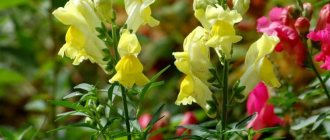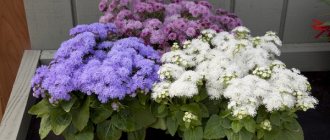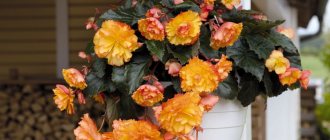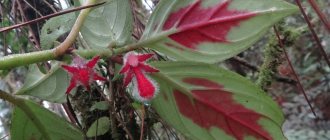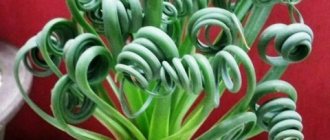Low herbaceous plants with lush greenery and bright flowers are Torenia. The buds have an original shape, reminiscent of an Orchid or Gloxinia, but the size of the flowers is smaller. Plants decorate cottages, gardens, flower beds near houses, balconies, terraces and loggias.
Where to plant an annual? What soils does Torenia prefer? Growing and care, preparing seedlings, choosing the right variety, disease prevention, descriptions and photos, advice from experienced gardeners - interesting and useful information for fans of bright colors and green decor.
Torenia: types and varieties for open ground
General information:
- herbaceous annual;
- the plant belongs to the Norichinaceae family;
- Torenia’s homeland is the humid zones of Africa, the tropical regions of Southeast Asia;
- a low bush with a creeping stem, average size - up to 30 cm;
- medium-sized flowers are similar to gloxinia and orchid, the shade of the upper and lower “lip” is often different;
- The color of the petals is varied: white, crimson, lilac, pink, yellow, blue, purple;
- Many hybrid varieties have been bred;
- many varieties have bright spots on the lower “lip”;
- the plant is highly decorative;
- buds bloom in August;
- a herbaceous perennial with spectacular inflorescences is grown in open ground and at home.
The herbaceous annual has many traditional varieties and hybrids. In natural conditions, botanists have counted more than forty varieties of Torenia. Many species have been cultivated, many interesting hybrid flowers with a varied combination of shades of the upper and lower “lips” have been bred. Before choosing flowering decor for a garden, cottage, or balcony, it is useful to find out more information on the topic: Torenia, photos, varieties.
Kawaii
Original petal color: magenta and lemon drop. An unpretentious, drought-resistant annual. A highly ornamental plant is a spectacular decoration for any area. The Toreniya Kawai variety is often used to decorate balconies and terraces.
Yellow
A spectacular variety of herbaceous perennial. The bushes are lush, branched, the stems are 25–30 cm long. The petals are deep yellow, with a bright purple spot on the lower lip.
Kauai mix
Early flowering variety, ampelous type of torenia. Small bushes (up to 20 cm in height) have many flexible branches. The plants are compact, neat in shape, suitable for decorating balconies, loggias, and growing in flowerpots. Long flowering period, wave-like release of buds. The highly decorative variety is often combined with other hanging torenia varieties.
Fournier
A popular variety with highly branching elements. The plant is grown at home and on the site. The leaf blades are ovoid, long, the buds are on short peduncles. The shade of the petals and lips is most often a combination of purple and deep blue. Breeders have developed interesting subspecies with new colors of lips and petals.
3.Varieties:
3.1. Torenia fournieri
A beautiful, profusely flowering, annual, shade-tolerant plant that will bloom even when grown in partial shade. The flowers are large, funnel-shaped, often of 2 shades - with 4 rounded, fused purple or pink petals and a white or yellow throat. The leaves are oblong-oval green, located opposite on the stems. The surface of the leaf blade has slight pubescence, and the edges have small denticles.
↑ Up,
Growing from seeds to seedlings
The best option for growing on the site or growing torenia as a potted crop for decorating balconies, loggias and terraces. Seedlings have been started since mid-February. To increase the percentage of germination, it is useful to treat planting material with growth stimulants.
After planting, the soil is sprayed, covered with glass or polyethylene is used: it is important to maintain high humidity during the “black earth” period. Every couple of days, the mini-greenhouse is opened slightly for 15 minutes: ventilation prevents the development of mold. Condensation is also removed.
Soil and container
To germinate seeds, use peat pots, a common container or a wooden box. The nutritious, light substrate contains charcoal and sand, peat, and garden soil.
You can purchase potting soil at a flower shop. The finished substrate is calcined to kill fungal spores. Another option for disinfecting the base is to water the soil with a strong solution of potassium permanganate.
Seedling care
After the first seedlings appear, the protective layer (polyethylene or glass) is removed and fresh air is allowed in. The container with torenia sprouts should be in a room with a moderate temperature: during the germination of grains, the optimal indicators are about +20..21°C. Sprouts need a cooler environment - about +18°C, otherwise the seedlings will grow before it gets warm enough outside and frosts on the soil stop.
Seedlings are grown taking into account the recommendations:
- watering. Moisten the substrate in a timely manner and monitor the condition of the soil: waterlogging is not necessary, but the dryness of the base also interferes with the active growth of seedlings. The water is settled and must be warm. Periodically loosen the substrate with a miniature tool;
- temperature. Do not keep peat pots with seedlings in a hot room, in direct sunlight. Do not allow the seedlings to dry out in a stuffy room. With a lack of light, the sprouts stretch out strongly in search of the sun, become thinner, and weaken. The optimal temperature for growing torenia seedlings is about +18°C;
- picking. When two leaves form, it is time to transplant the grown seedlings into separate containers, if the plants were in a common container. Act carefully, after moistening the substrate. Picking is stress for plants. After transplantation, it is useful to water the soil with the immunomodulators Zircon or Fitosporin to support torenia seedlings under the influence of negative factors;
- hardening. A mandatory procedure, without which seedlings cannot be planted on the site. Preparation continues for two weeks. The first two days, the seedlings are on the balcony for a quarter of an hour, then - 30-40 minutes, after four to five days - 1-2 hours, and so on. After two weeks, the hardened seedlings should spend the night in the fresh air. It is important that there is no frost, otherwise the sprouts will freeze.
Transplanting
Torenia sprouts are transplanted to the site only after the frosts have stopped. It is important that the air temperature is at least +16..18 degrees. The seedlings are first hardened off (the rules are described above).
To plant seedlings, you need a warm day, preferably with high clouds, but no rain. Strong wind, fog, heat are negative factors that negatively affect newly transplanted sprouts of an ornamental plant.
Choice of location and lighting
Warmth and sufficient light levels are optimal conditions in regions with a temperate climate. If a low-growing ornamental species is planted in hot areas, then it is useful to choose an area with light shade so that the delicate stems, leaves and buds do not get burned from the scorching sun.
For planting, choose a site that is not drafty, without swamps, and with a nutritious and loose substrate.
It is harmful if the plant experiences sudden changes in temperature. On a note! It is important that there are no stones in the soil: the plant is demanding on the quality of the soil. Be sure to remove weeds from the site and loosen the soil: harmful grasses often “clog” low-growing annuals with thin, often creeping, stems.
Landing rules
It is important to take into account the advice of experienced flower growers:
- check the area, remove weeds with their roots, loosen the damp, slightly dry soil;
- Dig small holes for each seedling. An interval of about 20–25 cm is maintained between the pits;
- first moisten the soil moderately, add a little organic fertilizer, then dig up the substrate and carefully level the surface;
- Place the sprouts in the holes, sprinkle the roots with soil, and tamp them down a little. There is no need to deeply bury young torenia;
- after planting, add a little settled, moderately warm water under each bush, wait until the moisture is absorbed, and mulch the planting area;
- fertilizing is carried out after 10 days;
- Young plants are watered moderately, make sure that weeds do not grow more actively than the herbaceous species, and periodically feed them.
Growing conditions - lighting, soil
Torenia comes from warm regions. In its homeland, Vietnam, it grows in shade and partial shade. Similar conditions need to be created in the garden or on the balcony where we are going to grow it. It is better to choose a place where the rays of the morning sun will fall (before 10 am), and then the flower will be in a slight shade. This should be the so-called light shadow. Such a place can be organized on a western or southern balcony or in a garden, under trees, in any position except the northern one.
If the chosen location has morning sun and afternoon shade, it is an ideal location. But, unlike most flowers, torenia is more likely to bloom in darker conditions. As long as there is plenty of indirect light, it will bloom. In particularly hot climates, full shade is also suitable for the flower.
If you can provide the plant with sufficient soil moisture at all times, it will also withstand the southern sun, provided that the shoots and leaves do not lean against glass or a wall that is hot from the sun. On constantly moist soil, it can grow in balcony boxes in a place protected from cold drafts.
Growing torenia in the garden is difficult because it is difficult to provide constantly moist soil, especially in hot weather.
To keep the soil moist in a box or other container without flooding it, it must be well-drained. Therefore, when preparing the soil, you need to add 1/3 of vermiculite or aquarium gravel with a small grain size to the soil. This is important, because if water stagnates in the substrate, the torenia will quickly begin to rot and die. It will die as quickly as during a drought.
So, the soil for digging should be:
- fertile;
- constantly wet;
- well drained.
A neutral pH level is fine, but torenia prefers light acidity. If possible, a pH range of 6.0-6.5 should be achieved. Before planting, you can use a pH meter to measure the acidity of the soil.
Outdoor care
A fairly unpretentious torenia plant develops well in partial shade and moderate lighting. The “transparent”, sparse crown of trees on the site does not interfere with abundant flowering and, at the same time, prevents the harmful effects of the scorching sun.
The main measures for caring for herbaceous annuals: moistening the substrate, adding organic matter and minerals, loosening, weed control, mulching. Transplantation of an annual species is not carried out unless there are serious indications, for example, infected plants have appeared on the site: a virus, fungus, dangerous bacteria.
Watering
Short periods of drought are less harmful to torenia than clayey, dense substrates and islands of water near the bushes, but it is more useful to stick to the golden mean. The soil is moistened as the top layer dries, taking into account the volume and frequency of precipitation. Water the plants quite often, but the amount of liquid is moderate.
Important details:
- During the release of buds, you need to carefully monitor the level of soil moisture: if the substrate is very dry, the flowers often wither and fall off, or the bright colors please the eye for a shorter period.
- When watering, proceed carefully: use a watering can with a long, narrow spout so that drops do not fall on the buds and leaves.
- Do not add cold liquid to the substrate.
- Infrequent loosening increases the risk of soil salinization; a dense crust is formed, which impairs soil aeration.
Disruption of the usual state of the environment negatively affects garden flowers. Fitosporin is a natural remedy that stimulates the immune defense and vitality of plants. On very hot days or when there are sharp temperature fluctuations, it is useful to water the fermentation with a working solution based on succinic acid.
Feeding and fertilizer
Mineral compounds and not very strong organic matter are added during the growing season and flowering period: natural and synthetic components alternate. Feeding is carried out every two weeks.
The soil is immediately moistened, then nutrients are added. To gain green mass, in the first period (vegetation) of threshing it should receive more nitrogen and phosphorus; during the release of buds and with the beginning of flowering, the concentration of Na is reduced and the concentration of potassium is increased.
Care during and after flowering
It is useful to water the low-growing species in time, loosen the substrate, and carry out weeding without delay so that weeds do not interfere with the growth and release of buds. All withered elements are removed in time, which activates the formation of new buds. Be sure to apply mineral fertilizers containing potassium.
On a note! If the plants are planted in an area with optimal illumination (with light shading during hot hours), then torenia will certainly please the eye and refresh the area.
Bush formation
For the first time, grown seedlings are pinched: the length of the sprouts reaches 8 cm. In young plants, after transplanting into a flowerpot or onto a plot, the upper stems are pinched: the plant bushes more actively. If necessary, remove all rotten, dry, broken, fungus-damaged elements from the tree. For varieties that resemble a ball, it is useful to maintain the optimal shape of the bush: at the beginning of summer, while the growing season is active, the stems are pinched in the right places.
Mulching, loosening
When growing torenia in flowerpots and on the plot, it is useful to periodically fluff up the soil for more active aeration. Loosening is carried out on a soft, loose substrate, which is pre-moistened. Weeds are removed as work progresses.
Peat mulch is poured in a thin layer under each bush when planting seedlings, and updated as necessary. Peat not only actively nourishes the soil during watering, but also prevents weeds from breaking through the mulch layer.
Sowing torenia seeds
Sowing torenia for seedlings is carried out at the standard time - at the end of February or in the first half of March.
Thorenia is sown according to the standard method:
- The containers are filled with soil and lightly leveled, being careful not to compact it.
- The soil surface is carefully moistened.
- Torenia seeds are scattered sparsely over the surface and covered with a thin layer of sifted soil or sand.
- The crops are re-moistened.
- The containers are covered with film or glass and placed in comfortable conditions.
Protection from pests and diseases
With proper care, torenia rarely gets sick. The stems may wilt and dry out if there is a lack of moisture; if there is excessive watering, fungus will develop. They fight mold on leaves, stems and soil using antimycotic agents - fungicides: Topaz, Skor, Bordeaux mixture, Hom, Fundazol, copper-containing compounds. The drugs are used according to the instructions. If the fungus is actively spreading, experienced gardeners advise disposing of the diseased bush so that mold spores do not fall on neighboring plants. Next, the area must be disinfected.
Important details:
- When harmful insects are identified, parasites are collected manually and all parts of the tree are inspected.
- When the colony size is small, folk remedies are used to treat infected plants: soap solution, garlic tincture, tobacco decoction. When pests actively multiply, insecticides are used.
- When spider mites settle in a dry environment, chemicals from a different group are used to kill pests - acaricides.
- It is important to normalize growing conditions, prevent waterlogging and drying out of the soil.
- To prevent the infestation of parasitic insects and mites, it is useful to prepare the soil according to the rules, and the purchased substrate must be disinfected.
- You should not allow dense plantings: a lack of space for growth and development makes the plants weaker, making it easier for pests to move from bush to bush.
- When using chemicals, the grower must protect the body from contact with acaricides and insecticides. You will need closed clothing, a hat, plastic glasses, thin rubber gloves, and a respirator. Neglecting simple safety measures increases the risk of vapors and droplets penetrating the skin, mucous membranes, respiratory tract and eyes.
Picking seedlings and caring for young torenias
Torenia seedlings are planted as soon as two true leaves are formed. The sooner transplantation into individual containers is carried out, the better. For harvesting, small pots with a diameter of about 10 cm are usually used. The plant is picked one at a time, rarely in pairs.
Caring for torenia after pruning does not differ from caring for seedlings, but the plant is transferred to regular watering and kept cool, at a temperature of 16 to 18 degrees. A mandatory measure is pinching the shoots, which allows you to form very dense bushes. Overmoistening and drying out the substrate for seedlings are equally dangerous.
10 days after the dive, you can begin to carry out standard fertilizing for torens, which are planned to be grown in a pot culture. For ground plants, fertilizing is not necessary.
Reproduction
Torenia is bred at home and on the site only with the help of seeds. They are engaged in seedlings according to the recommendations given in the previous sections. Some gardeners sow seeds directly onto the plot, but only in warm regions do bushes and flowers have time to form.
You need to remember: buds form in August; when grown without seedlings, the flowering period occurs in autumn with unstable temperatures and less favorable conditions. Weak bushes bloom worse and get sick more often.
Soil and containers for sowing
Torenia is sown in shallow large containers or bowls with good drainage holes.
The substrate for this summer plant can be used as a universal substrate for growing seedlings. A simple mixture of garden or all-purpose potting soil with vermiculite or sand will also work. For diving, you can use special soil mixtures for geraniums (pelargoniums). If possible, hydrogel can be added to the soil to stabilize moisture and protect against drying out. Before sowing, it is advisable to disinfect or calcine the soil.
Torenia in landscape design
Note to amateur flower growers:
- Low, compact and ampelous varieties of highly decorative annuals look good against the backdrop of a well-groomed, green lawn.
- An interesting planting option: a combination of bright colors of decorative tobacco, torenia and petunia.
- Hanging varieties with creeping elements are a delicate, effective decor for hanging flowerpots and decorative, rather tall floor vases. Place the compositions on the loggia, balcony, terrace, and decorate the patio area.
- Torenia can be used to make a low border, but varieties with creeping stems are not planted close to the edge of paths. Low-growing, compact varieties that look like large balls are suitable for decorating this zone.
- Fresh notes are given to the garden and dacha by planting torenia, which involves several varieties with a similar bush shape, but a different shade of petals.
- You can choose two or three varieties with rich crimson, lilac, yellow, white petals and a lip on which there are rich spots of color.
- Torenia plantings are never boring, especially when using the optimal combination of tones.
Suitable companion plants:
- Marigold.
- Salvia.
- Aquilegia.
- Verbena.
- Nasturtium.
- Sulfinia.
- Petunia.
When combining with other plants, it is important to consider what type of low-growing flower the grower is growing: ampelous or groundcover.
Torenia is an interesting herbaceous species for decorating a garden, balcony, or patio area. Unusual flowers combine the characteristics of orchid and lobelia; rich green shades complement the bright colors of the buds. Growing torenia from seedlings is quite simple; seed germination is sufficient. In general, the plant is unpretentious, and every year it gains recognition from an increasing number of amateur gardeners.
Want to know more useful information about growing Torenia? Watch the video below:
Selecting seeds for sowing
Torenia is one of the fairly common annuals, but to grow plants from seeds, you should be careful when choosing them. For threshing, you need to carefully study information about the manufacturer, the characteristics of the variety, and sowing dates. It is better to choose trusted companies and garden centers whose seeds you are convinced of the good quality.
The too low price and lack of information should alert you: low-quality torenia seeds come across quite often, surprising with their extremely low germination rate. But seeds can be purchased from trusted manufacturers for 2-3 years, without loss of germination (about 98% under optimal storage conditions).
Self-collecting torenia seeds, especially from potted and indoor plants, allows you to obtain a large number of seeds even from one plant. But since flowering must be sacrificed to ripen the fruit, and almost all varieties are of hybrid origin, it is difficult to preserve their characteristics and achieve the desired results with such propagation. Therefore, this plant is most often grown from purchased seeds.
Sowing torenia for seedlings. © gardeneverything
Torenia as a houseplant
If the plant is grown in an apartment, you need to maintain its optimal temperature of 16 degrees Celsius. It is important to periodically ventilate the room, especially if the temperature is higher than necessary. In the cold season, the torenia flower can be kept at 8 degrees Celsius. But the temperature should not be lower than +5 degrees.
In the room where torenia is grown, the air should not be too dry, which is difficult to achieve with simple spraying. Therefore, it is advisable that the container with the plant be placed on a tray with wet pebbles. Watering should be quite frequent, but it is not recommended to over-moisten the soil. Usually twice a week is enough. Before watering, you need to wait until the top layer of soil dries.
Caring for torenia correctly
Torenia is capricious, growing and caring for it requires knowledge of certain rules.
Rule one: although the flower loves the sun very much, at the same time it cannot stand its direct rays. Delicate velvet flowers dry out, so torenia should grow in places with diffused light.
Second: the soil in the pot should always be moist; you can use hydrogel granules for this. If the air is too dry, the plant is thoroughly sprayed.
Third: the plant does not tolerate sudden temperature changes, so indoor planting should not be located near a radiator or in a draft.
Fourth: when watering, drops of moisture should not fall on the flowers and leaves.
Fifth: home care requires careful loosening of the soil to better ventilate the roots and prevent the development of mold in the soil. Every 14 days, the torment needs to be fed with fertilizers for indoor flowers (complex liquid or solid mineral).
Sixth: to enhance flowering, faded buds and wilted flowers are removed from the bush - the plant does not know how to shed them on its own.
Letnik for ampels and pots
A distinctive feature of torenia is that it is grown almost exclusively in potted and container form. The leaves of torenia are very capricious, the plant easily sheds its greenery, and this factor requires the choice of special, protected growing conditions. But it is impossible to ensure optimal parameters in open ground. Therefore, in landscape design, annual torenias are used:
- as a bright potted soloist;
- as an ampelous plant;
- in balcony boxes;
- for decorating mixed container compositions;
- in stone flowerpots and tall flowerpots;
- for decorating recreation areas, terraces, balconies, etc.
Torenia.
Serres Fortier Torenia can be planted in the soil only in protected places - near recreation areas, gazebos, under a terrace canopy or in raised flower beds, flower beds above a supporting wall, along the edge of a terrace area. But even in an ideal place, torenia can die from the vagaries of the weather. The best companions for torenias include balsams, lobularia, zinnias, argyrantemum, hosts and lantana.
Description of the plant
Torenia received its name in honor of Red Olaf Toren. He was a student of Carl Linnaeus. While in India, Toren sent samples of this flower. Having a variegated color, the plant received the second name “clown flower”. Previously, the perennial was considered one of the Norichnikov species. Today he is a representative of the Lindernievs. The most common variety of Torenia, which can often be seen in flower shops, is Torenia fournieri (Torenia Fournier). Has blue-violet flowers. The plant begins to bloom in spring. Abundant flowering continues without stopping almost until the end of autumn. In winter, if desired, the flower is brought into a room where the air temperature does not exceed +8 degrees.
Conditions suitable for towing
Selecting suitable conditions is the most difficult thing in growing torenii. This plant is specific mainly because the foliage of torenii is extremely sensitive and easily falls off under unfavorable conditions. Torenia leaves can be shed in direct sunlight, from getting wet or from an active draft. And it is foliage, and not flowering, that dictates the choice of growing conditions. Torenium flowers are much less capricious.
Lighting for toreni should be quite secluded. For this, plants choose partial shade or a light, diffused place. But the main thing when choosing locations is to choose a site where the tornados will not be exposed to the scorching rays of the sun for even half an hour. A prerequisite is reliable protection from winds and drafts, precipitation and rain. That is why torenia is almost never grown in open soil, but is planted in pots that can be placed in protected areas.
Torenia. Tim Waters
The soil for threshing is not particularly specific. Any fertile and well-drained soil will suit it. Loose texture, water and breathability should be very good. Ready-made substrate or high-quality garden soil - the choice is yours. When planting this plant, be sure to provide drainage.
